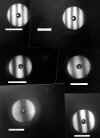|
|
|
|
Autocollimation Mirror tests |
Click on the photo for full size. | |||
|
Here are some examples of mirrors tested in an autocollimation setup using a flat reference mirror. This is a doublepass arrangement meaning that the light bounces twice off the mirror under test and errors are shown doubled compared to a test applied to a star or using another scope as a collimator. For a parabolic mirror, this is a null test and is fairly easy to interpret visually (I use Ronchi screens) though it does not provide an easy means to quantify as may interferometric fringes. Using a Ronchi screen, many find it easier to judge for the desired straight lines than for the subjective curves a paraboloid presents at center of curvature. In a shop environment with steady air, it can be quite effective compared to similar testing on a star with the attendant problems of atmospheric disturbance. As with longer f/ratio optics tested at center of curvature, the test performs better with the wider tolerances afforded by long focus instruments. With proper diligence, fast systems can be examined and when used in conjunction with star testing using intra/extra focal patterns, short f/ratio scopes can be made of very high quality indeed. Note that null testing doesn't make figuring any easier but it can help better identify the errors being dealt with. Some photos show effects of heat waves in my shop. The dirt and scratches are from the flat mirror and also the flat bed scanner. |
Comparison of null and center of curvature tests.
Mirrors in stock: |
|||
 8" f/6 |
||||
 Back to main |